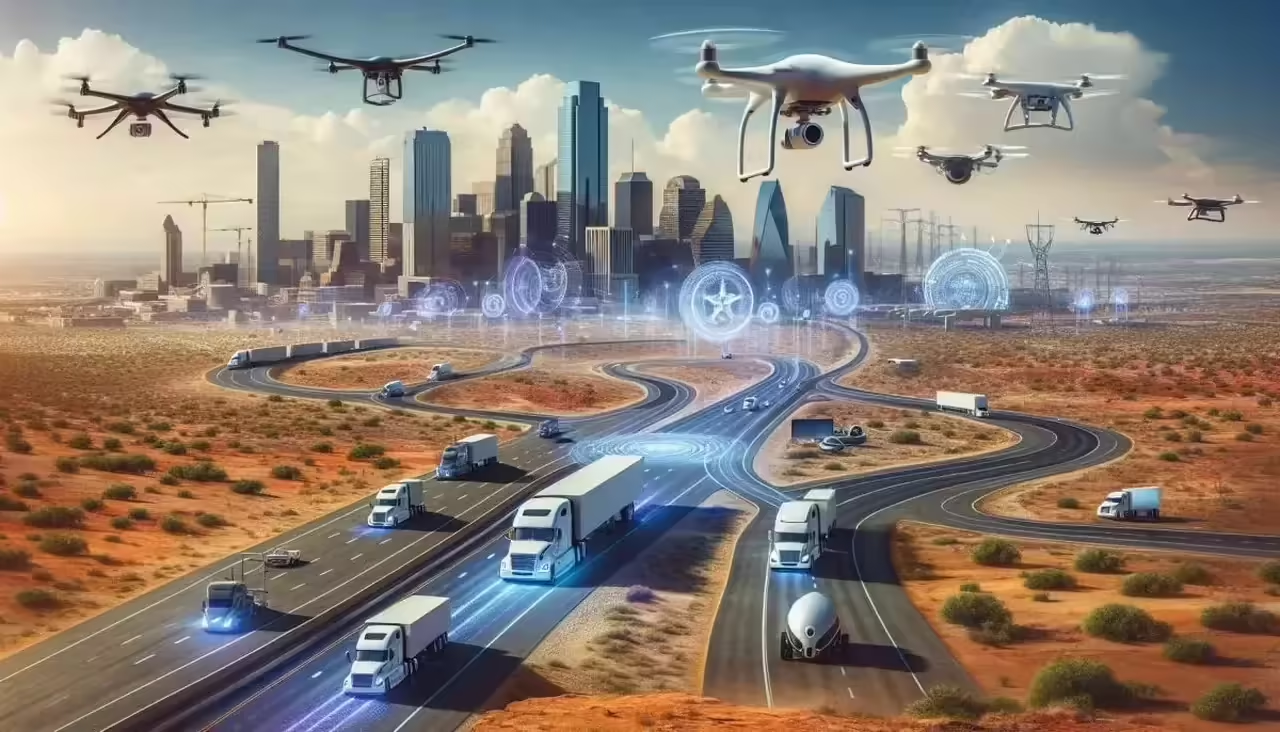
Drones, also known as Unmanned Aerial Vehicles (UAVs), have undergone a technological revolution in recent years, marked by significant innovations in design and functionality. These advancements have not only expanded the potential applications of drones but have also improved their performance and efficiency. In this article, we will explore the latest innovations in structure and materials, as well as the technical features propelling drones to new heights.
Advancements in Structure and Materials:
Foldable Design: One of the most notable innovations in drone structure is the implementation of foldable designs. This allows drones to be more portable and easier to transport, particularly beneficial for enthusiasts and professionals who need to travel frequently.
Lightweight and Resilient Materials: The use of advanced materials such as carbon fiber and aluminum alloys has enabled the manufacturing of lighter drones without sacrificing strength. This combination has improved the durability and agility of drones, enabling them to handle adverse conditions more effectively.
Aerodynamic Design: Aerodynamics plays a crucial role in drone performance. Designers have worked to perfect the shape and arrangement of propellers to optimize flight efficiency, reducing resistance and enhancing stability.
Technical Features Enhancing Performance:
Advanced Stabilization Systems: Stabilization is essential for capturing high-quality images and videos. Modern drones incorporate gyroscope and accelerometer stabilization systems, as well as technologies like GPS and GLONASS, to ensure smooth and precise flight.
Extended Battery Life: Autonomy has always been a challenge for drones. However, lithium polymer batteries and other emerging technologies have significantly improved flight duration, allowing drones to operate for more extended periods.
Smart Sensors: Modern drones are equipped with a variety of sensors, such as infrared cameras, lidar, and ultrasonic sensors, enabling them to detect obstacles and adjust their route automatically. This not only enhances safety but also expands the range of applications in complex environments.
Artificial Intelligence and Machine Learning: The integration of artificial intelligence algorithms and machine learning enables drones to make smarter decisions in real-time. This is especially useful in tasks such as object tracking, obstacle avoidance, and route optimization.
Integration of Artificial Intelligence in Drone Systems: Empowering Autonomy with Machine Learning
The convergence of artificial intelligence (AI) and drones has led to significant advances in the capabilities of these unmanned aerial vehicles. The incorporation of machine learning algorithms has revolutionized how drones operate, allowing them to perform complex tasks autonomously.
Use of Machine Learning Algorithms:
Object Recognition: Machine learning algorithms enable drones to recognize and classify objects in real-time. This is crucial for applications such as surveillance and security, where drones can automatically identify people, vehicles, or other relevant objects.
Autonomous Tracking: Drones equipped with tracking algorithms can identify and follow targets autonomously. This is particularly useful in applications such as cinematography, monitoring sports events, or tracking search and rescue operations.
Obstacle Detection and Avoidance: Machine learning algorithms enable drones to analyze the environment and make real-time decisions to avoid obstacles. Sensors such as cameras, lidar, and ultrasound combine with these algorithms to ensure safe flights and prevent collisions.
Route Optimization: Drones can use machine learning-based route planning algorithms to optimize their trajectory. This is crucial in situations where energy efficiency is required or in delivery operations, where various factors such as air traffic and weather conditions need to be considered.
Applications of AI for Autonomous Decision-Making:
Inspection and Maintenance: AI-equipped drones can perform inspections of infrastructure such as power towers, transmission lines, and industrial structures. AI analyzes the collected data to identify potential issues and, in some cases, can make immediate decisions, such as scheduling repairs.
Precision Agriculture: In agriculture, AI-enabled drones can analyze multispectral images to assess crop health and determine the needs for irrigation or fertilization. This allows for more efficient and sustainable agricultural management.
Supply Distribution in Remote Areas: Autonomous drones can carry out delivery missions in remote areas using AI-optimized route algorithms. This is crucial in emergency situations or regions where ground access is limited.
Environmental Monitoring: Drones equipped with specialized sensors and algorithms can monitor air quality, water temperature, and other environmental parameters. The collected information contributes to decision-making in environmental management.
Security and Privacy in Drone Use: Ensuring Responsible and Secure Deployment
As drones become ubiquitous in various industries and applications, it is imperative to address critical security and privacy issues associated with their use. We will now examine two fundamental aspects in this context: protection against cyber-attacks and considerations on data privacy.
Protection against Cyber-attacks:
Data Encryption: The transmission of data between the drone and the controller must be secure. The implementation of robust encryption protocols ensures that sensitive information, such as images or flight coordinates, is not vulnerable to malicious interceptions.
Network Security: Drones are connected to wireless networks for communication with the controller or base station. Strengthening the security of these networks is essential to prevent intrusions and unauthorized access that could compromise drone control.
Secure Software Updates: Drone manufacturers should provide regular software updates addressing known vulnerabilities and strengthening defenses against new cyber-attacks. Users, in turn, must be diligent in applying these updates to keep their systems secure.
Detection and Prevention of Attacks: Incorporating intrusion detection and attack prevention systems in drones can help identify and mitigate potential cyber threats. These systems can alert about suspicious activities and take measures to avoid damage.
Considerations on Data Privacy:
Regulatory Compliance: It is crucial to comply with local regulations and norms related to data privacy. This may include obtaining specific permits for certain types of operations and restricting access to the collected information.
Data Anonymization: Whenever possible, data collected by drones should be anonymized to protect the identity of individuals. This is especially important in applications such as urban surveillance or data collection in public areas.
Notification and Consent: Informing people about the presence and purpose of drones, as well as obtaining their consent when necessary, contributes to building a trusting relationship and addresses legitimate concerns about privacy.
Secure Storage: Data captured by drones must be stored securely, and access should be limited to authorized personnel only. Adopting encrypted storage practices and restricting physical and virtual access are essential measures.
Limited Retention Period: Defining a limited retention period for data collected by drones helps minimize risks associated with prolonged storage and reduces the chances of misuse.
Developments in Batteries and Energy Efficiency: Boosting Drone Autonomy
The performance of drones is intrinsically linked to their autonomy and energy efficiency. In recent years, there have been notable advances in battery technology and strategies to improve the energy efficiency of these devices, marking a milestone in expanding their applications.
Advances in Battery Technology:
Solid-State Batteries: One of the most promising innovations is the development of solid-state batteries. These batteries replace conventional liquid electrolytes with solid materials, improving safety and increasing energy density. This results in drones with greater autonomy and extended flight times.
Graphene Batteries: Graphene, a carbon-derived material, has shown exceptional properties in battery applications. Graphene batteries offer higher charge capacity, longer life cycles, and faster charging times, representing a significant improvement compared to conventional batteries.
Advanced Cathode Technologies: Researchers have been working on developing more efficient cathodes, such as using lithium-nickel-manganese-cobalt (NMC) or solid-state materials. These advances increase energy density and battery stability, contributing to more consistent performance.
Wireless Charging: Wireless charging is emerging as a viable option for drones. This technology allows drones to recharge automatically when stationed at a charging station. In addition to reducing downtime, it also simplifies charging operations.
Strategies to Improve Energy Efficiency:
Optimized Aerodynamic Design: Optimizing the aerodynamic design of drones reduces wind resistance and improves flight efficiency. By reducing aerodynamic load, drones require less energy to stay airborne, resulting in increased autonomy.
Efficient Propulsion Systems: Choosing more efficient propulsion systems, such as high-performance electric motors, contributes to better energy efficiency. Additionally, the use of more efficient and lightweight propellers can improve the thrust-to-energy ratio.
Intelligent Energy Management: Implementing intelligent energy management systems allows drones to dynamically adjust their power consumption based on flight conditions and assigned tasks. This ensures efficient use of available energy.
Energy Efficiency Sensors: The integration of advanced sensors that monitor the drone’s state and automatically adjust its performance to optimize energy consumption is a key strategy for improving operational efficiency.
Optimal Battery Charging: Implementing intelligent charging algorithms that optimize charging speed and the charging process can prolong battery life and ensure more efficient use of stored energy.
Specific Applications in Agriculture and Surveillance: Optimizing Resources with Drones
Drones have proven to be versatile tools in various sectors, and two areas where their presence is particularly prominent are agriculture and surveillance. Below, we explore specific applications in these two disciplines, highlighting how drones are revolutionizing crop monitoring and contributing to security and surveillance in specific areas.
Use of Drones in Crop Monitoring:
Field Surveillance and Mapping: Drones equipped with multispectral and thermal cameras can conduct detailed inspections of agricultural fields. This enables farmers to detect issues such as pests, diseases, nutritional deficiencies, and water stress early on, optimizing crop management.
Terrain Topography Mapping: Accurate terrain topography is essential for agricultural planning. Drones can generate detailed 3D models of the terrain, facilitating planning for planting, irrigation, and agricultural machinery management.
Precision Application of Fertilizers and Pesticides: The controlled flight capability and precision in data capture enable drones to apply fertilizers and pesticides selectively. This not only reduces the use of chemicals but also improves efficiency and lowers operational costs.
Crop Growth Monitoring: Drones can regularly monitor crop growth, providing farmers with detailed information on plant health and development. This facilitates informed decision-making regarding the right time for harvesting.
Contribution to Security and Surveillance in Specific Areas:
Border Surveillance and Remote Areas: Drones play a crucial role in surveilling border areas and remote locations that are difficult to access. Equipped with high-resolution cameras and advanced sensors, they can efficiently patrol extensive areas, identifying suspicious activities or potential threats.
Monitoring Natural Disasters: In situations of natural disasters such as floods, wildfires, or earthquakes, drones can be deployed to assess damage, locate survivors, and coordinate rescue efforts. Their ability to access challenging areas ensures a quicker and more effective response.
Critical Infrastructure Surveillance: Drones equipped with high-resolution cameras and specialized sensors are used for the surveillance of critical infrastructures such as power plants, dams, or industrial facilities. This helps prevent illegal activities or security incidents.
Traffic Control and Mass Events: In massive events or traffic control situations, drones offer a valuable aerial perspective for monitoring large crowds and optimizing traffic management. This contributes to public safety and facilitates real-time decision-making.







